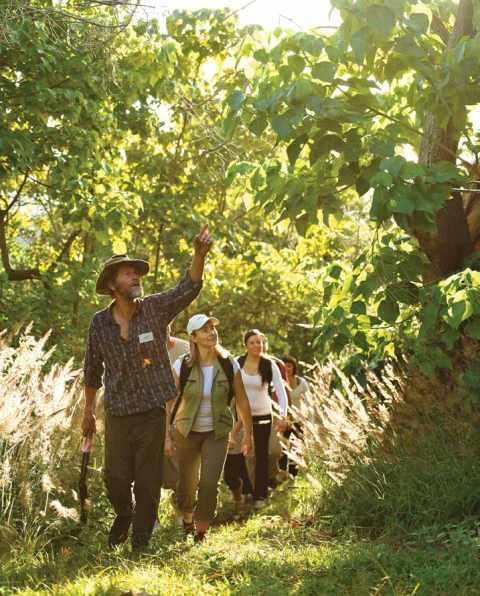Communing with nature is nothing new; but increasing attention is being placed on the benefits. Nature is seen as the antidote to our modern, stressed lives. At spas this is translating to an eco trend that focuses on a combination of ‘nature and nurture’ inspired treatments.



The serenity of the outdoors gives new meaning to relaxation
Communing with nature is nothing new; but increasing attention is being placed on the benefits. Nature is seen as the antidote to our modern, stressed lives. At spas this is translating to an eco trend that focuses on a combination of ‘nature and nurture’ inspired treatments.
Bath Time
The ‘nature and nurture’ eco spa trend began with forest bathing. It involves ‘bathing’ among the trees, but no bathtubs are involved. Instead it is a slow forest walk while focusing on the present moment, tying into the growing shift towards mindfulness. The practice became a government initiative in Japan in 1982 as a relaxation and stress management activity, and an estimated 25 percent of the Japanese population do it regularly.
It seems to be gaining global significance and entering spas due to studies showing health benefits for the mind and body, such as lowering blood pressure and heart rate, alleviating stress and depression, and boosting immunity. Benefits from walking in nature, engaging the senses, breathing deeply, and in some cases the inhaling of antimicrobial volatile substances, such as essential oils from trees, can work wonders.
Into the Woods
There are many growth indicators including the rise of professional forest therapy. For example US-based Association of Nature and Forest Therapy will provide training and guide certification courses in the US, Canada and New Zealand in 2016. One of these is L’Auberge de Sedona, Arizona.
According to the retreat, “a facilitator will lead guests into a timelessness shift, where through a series of invitations, they immerse and commune with nature, creating an experience like never before.” The spa menu offers private and group forest bathing, and a feet-in-the-creek foot treatment. In Japan, the Chedi Tomakomai (a GMH hotel to open in 2017), situated in a forest on Hokkaido, will have guided forest therapy as a key part of its wellness programme.

THIS PAGE: The Datai Langkawi’s spa comprises of open-air villas situated against the backdrop of a rainforest. OPPOSITE PAGE: Guided hikes are offered at Gwinganna Lifestyle Retreat
Great Outdoors
There are other ways too in which spas are offering experiences that reflect this ‘nature and nurture’ trend. Nature plays a role on a number of levels at ecotourism-certified Gwinganna Lifestyle Retreat, set on 200 hectares of lush Australian hinterland and rainforest, with sweeping valley and ocean views. In the morning guests are encouraged to pursue an activity, one of which is guided bush walking among ancient trees (the Aussie version of forest bathing).
In the afternoon guests indulge in Dreamtime, to nurture while focusing on health and wellness. Many options are nature based including semi outdoor spa treatments, such as the Miryani Ritual. It begins with a circling of sage and a meditation to ‘honour the elements of nature’ and includes a billabong foot bath, a body polish made using indigenous ingredients, and poultices made from wild native herbs, dipped in local macadamia oil.
There is also a treatment using the healing sounds of a didgeridoo. Sharon Kolkka, general manager and wellness director, says, “Part of any stay at Gwinganna involves connecting to our natural environment and being outdoors. Taking time to explore and appreciate the beauty of such an environment is now proven to be good for our health. It can boost our sensory awareness, improve our feelings of purpose and make us feel happier and more relaxed.
And a recent study looked at the role of positive emotions in preventing lifestyle diseases and the direct influence upon health and life expectancy.” Jungle Beat Another property making the most of its location is The Datai Langkawi. Its spa comprises of open-air villas situated along a winding stream against the backdrop of an ancient rainforest. “Each treatment room intentionally utilises nature, enveloping guests in tranquil sights, meditative nature sounds and subtle scents of the jungle,” says Angeline Lim, director of spa.
Treatments often involve bringing nature into the treatment room, including a new body treatment introduced in March. “Tungku Batu (heart of stone) is designed to relax, rejuvenate and reconnect with nature, uses stones from the river and healing rainforest herbs,” says Lim. Each treatment is further nature enhanced by the use of its Sound Bath, used to deepen effects – the recording captures the sounds of hundreds of birds and wildlife found in the rainforest.
Wild Essence
Though city spas may not be able to provide nature, they are harnessing its benefits, and embracing the trend in other ways. Forest essential oils, for example, are making their way into treatments and products, with Korea leading the way. Many of its day spas are infusing saunas with forest oils combined with negative ions (a natural air purifier) to create a faux-forest ambience which can produce the same benefits of an actual one.
At The Langham, Chicago, its Chuan Spa has a Herbal Sauna that uses locally sourced herbs beneficial for the respiratory system, and its Himalayan Salt Stone Sauna releases negative ions for a mountain clean and calm environment. Even the sunshine can benefit, especially for city dwellers who spend most of the day bathing in the light of their computer screen.
During summer the hotel has been known to offer mini massages and yoga on the plaza by the Chicago River, while guests at The Langham Huntington, Pasadena (also home to a Chuan Spa) can commune with nature in the tranquillity of its wooded, Japanese Garden.
Even the sunshine can benefit, especially for city dwellers























